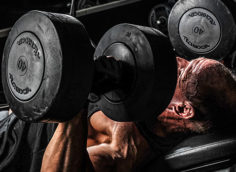In my last article, I wrote about being balanced in all your lifts. Now, I'd like to take a step back and conquer a bigger topic – the need for balance between bodyweight movements and weighted movements.
In this definition of balance, I'm referring to a 1:1 ratio between the major movements. This means that if you do the bench press, you should also do push-ups. If you do seated rows, you should also do inverted rows. A lot of us know this, but do you do it? And if you do, is it with equal effort?
Bless her 'lil tanned tummy, she's trying her best.
It seems that lately, people have been arguing over which type of training is better or more effective, weight training or using just bodyweight. But there shouldn't actually be an argument over which one you should do. Eliminate that thinking right now and do them both, period! They both offer unique benefits, so stop limiting yourself to just one style.
But I Thought I Outgrew Those?
The truth is, most of us started out with bodyweight training when we were younger. As we improved, we naturally evolved to weight training for more of a challenge. At the time, weight training offered you a greater stimulus, and therefore a greater payoff.
Also, weight training gave you something to progress towards... lifting more weight. After all, you can only do so many push-ups before you get bored.
Well, we do still need bodyweight exercises. Not just as a warm-up, but as a progressive-resistance training tool. That means that we need to move from quickly banging out a few reps, to having a specific goal and working hard to accomplish it, just like your lifting.
I think that's the main problem with traditional, old-style bodyweight training. You had nothing to progress towards. Once you could do X number of reps, you just kept repeating that every workout.
Rules To Live By
- You should include a bodyweight exercise and a lifting exercise for every major pattern you train. Horizontal, vertical, push, pull...the whole deal. The major bodyweight exercises include the push-up, inverted row, pull-up, handstand push-up, squat, split squat (Bulgarian squat) or lunge, and calf raise.
- "Bodyweight" doesn't mean that you can't add additional weight for resistance. You can, and probably should, once you reach your desired rep range. Weighted vests and dip belts come in handy for this.
- The real key is to actually have a progressive goal for your bodyweight training. You wouldn't lift weights without trying to get better, so why would you train with your bodyweight any differently?
Progression Examples
Push-Up (Guys/Gals) Reps
- Standard Push-up — 30 / 15
- Feet elevated — 30 / 15
- Extended range of motion (ROM) — 30 / 15
- Feet elevated with extended ROM — 30 / 15
- Standard push-up with external weight — 30 / 15
- Repeat Goals 2-5 with external weight
Inverted Row – Reps
- Incline (Head higher than feet) — 10
- Horizontal (Head level with feet) — 10
- Horizontal with rotating handles — 10
- Add external weight — 10
Pull-up – Reps
- Assisted (Lift less than bodyweight) — 10
- Pull-up with bodyweight — 10
- Pull-up with external weight — 10
- Add reps without external weight — 20
- Add reps with external weight — 15
- Progress with weight and/or reps —
Handstand Push-up – Reps
- Learn technique, perform one rep
- Add
- Extended ROM
- Add reps with extended ROM
Squat – Reps
- Bodyweight squat — 40
- Dumbbell squat — 40
- Goblet squat — 40
- Add reps to bodyweight squat — 50
- One-leg squat — 6
- One-leg squat with added weight —
Split Squat – Reps
- Split squat — 20/leg
- Bulgarian squat — 20/leg
- Add reps to split squat — 40/leg
- Add reps to Bulgarian squat — 40/leg
- Lunge — 20/leg
- Add reps to lunge — 40 Reps per leg
- Add external weight to each movement —
Calf Raise – Reps
- Calf raise with two legs — 20
- Calf raise with one leg — 20
- Calf raise with two legs, series * — 36
- Add reps to calf raise with one leg — 30
- Add reps to calf raise with two legs — 40
* Calf raise series is 12 reps with toes turned in, 12 reps with toes turned out, followed by 12 reps with toes forward.
Summary
You now have seven bodyweight progressions to balance your already productive weight-training program. Just remember to keep your training balanced. Train both weighted and non-weighted basic patterns. Have goals for each, and keep them progressive. More reps, harder variations, added weight. Whatever it takes. It can't get any easier, or better, than that.






